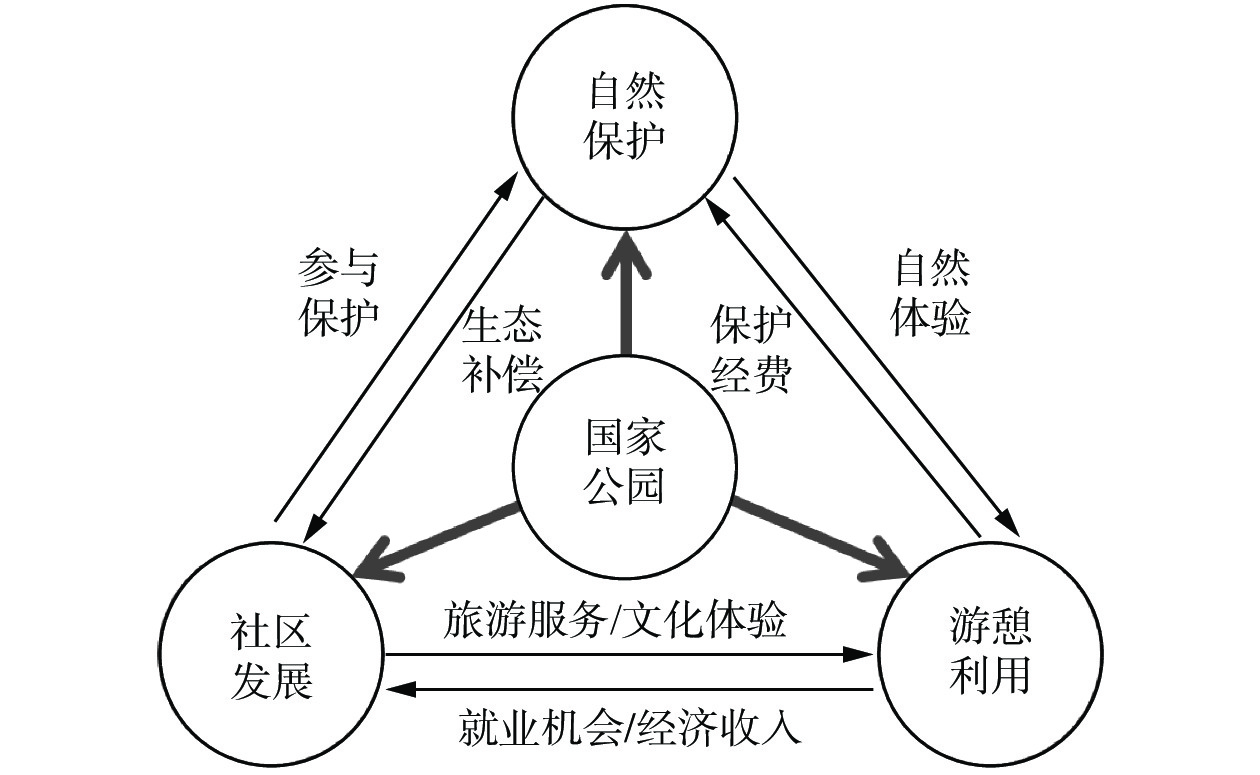Discussion on the Necessity and Pathway of Appropriate Development of Tourism in National Parks of China
-
摘要: 严格保护的同时兼顾合理利用是国家公园区别于自然保护区的重要特征,适度发展旅游是国家公园合理利用的主要方式。在我国,发展旅游被视为是对自然保护的威胁,国家公园该不该以及应如何发展旅游,是中国国家公园体制建设中须直面的重要问题。剖析了当前中国国家公园建设中重保护、轻利用的倾向,然后从3个方面阐述了国家公园发展旅游的必要性。首先,适度发展旅游是国家公园实现综合功能的内在要求, 有助于促进实现国家公园的保护、科研、教育和游憩等综合功能;其次,国家公园发展旅游是中国国民经济发展的现实需求,有助于协调国家公园保护和发展的二元矛盾,有助于满足人民群众美好生活的需要,既是践行“两山理论”的客观要求,也是实现“乡村振兴”的重要手段;第三,国家公园适度发展旅游是国际通行的做法。国家公园发展旅游应坚持可持续原则,并提出了具体的发展建议。Abstract: Making necessary and reasonable use while conducting strict protection is one of the biggest features differentiating national parks from nature reserves. Developing tourism appropriately is one of the leading ways to reasonably use natural resources in national parks. However, tourism has been viewed in China as fierce as flood and savage beast threatening the protection of nature. Whether it is able to and how to develop tourism in national parks of China is a huge challenge confronting Chinese national park authorities. In this paper, the author argues the necessity and significance of appropriate tourism development for national parks. First of all, developing tourism appropriately is the internal demand of national parks management, since it can help to fulfill the overall functions of national parks, including education, recreation as well as protection. Secondly, appropriate tourism development in national parks can meet the strategic need of national economic and social development in China. It can play important roles in harmonizing the contradiction between development and protection, and meeting the needs of Chinese people for good life. It is the realistic requirement to practice "Two Mountains Theory" and also an important measure to realize the strategy of "Rural Revitalization". Thirdly, appropriately developing tourism is the prevailing way to rationally use national parks around the world, and it is also proved to be the key to achieve the success of national parks management. In the end, the author makes some proposals in terms of how to promote the sustainable future development of tourism in the newly-established national parks.
-
Keywords:
- national park /
- tourism /
- eco-civilization /
- protection and development
-
-
表 1 部分国家公园纲领文件和部分试点区总体规划中关于保护和利用的词频统计
次 国家公园相关文件和规划 公布时间 相关词语 保护 利用 游憩 教育 旅游 《建立国家公园体制总体方案》 2017年9月 75 3 2 6 1 《关于建立以国家公园为主体的自然保护地体系的指导意见》 2019年6月 199 8 1 3 2 《东北虎豹国家公园总体规划(2017—2025)(征求意见稿)》 2017年12月 409 57 4 54 16 《三江源国家公园总体规划》 2018年1月 356 49 0 60 7 《神农架国家公园体制试点建设白皮书(2017)》 2018年3月 105 5 6 3 8 《祁连山国家公园总体规划(征求意见稿)》 2019年2月 488 48 0 64 14 《大熊猫国家公园总体规划(征求意见稿)》 2019年10月 462 40 0 75 12 《海南热带雨林国家公园规划(2019—2025)》 2020年4月 432 51 9 83 34 表 2 部分试点国家公园常住人口数量
国家公园 所在省份 面积/km2 园区内人口数 人口密度 /(人·km−2) 三江源国家公园 青海 123 100 64 000 0.52 祁连山国家公园 青海、甘肃 50 200 54 665 1.09 大熊猫国家公园 四川、青海、甘肃 27 134 120 800 4.45 神农架国家公园 湖北 1 170 21 072 18.01 东北虎豹国家公园 吉林、黑龙江 14 926 92 993 6.23 钱江源国家公园[13] 浙江 252 9 744 38.67 武夷山国家公园 福建 942 3 352 3.56 海南热带雨林国家公园 海南 4 403 31 100 7.06 注:除钱江源国家公园外,其余国家公园试点区人口数据分别来自《三江源国家公园公园总体规划》《祁连山国家公园总体规划(征求意见稿)》《大熊猫国家公园总体规划(征求意见稿)》《神农架国家公园社区发展规划(2019—2028)》《东北虎豹国家公园总体规划(2017 —2025)(征求意见稿)》《武夷山国家公园社区发展专项规划》《海南热带雨林国家公园规划(2019—2025)》,普达措和南山国家公园的规划文本没有公布,网上也没有相关数据的报道,故数据缺失。 表 3 部分国家国家公园接待游客与旅游收入统计
表 4 2014—2018年美国10个国家公园游客接待量统计[20]
人次 公园名称 时间 5年平均值 2014 2015 2016 2017 2018 大烟山(Great Smoky Mountain)国家公园 10 099 276 10 712 674 11 312 786 11 338 893 11 421 200 10 976 966 大峡谷(Grand Canyon)国家公园 4 756 771 5 520 736 5 969 811 6 254 238 6 380 495 5 776 410 洛基山(Rocky Mountain)国家公园 3 434 751 4 155 916 4 517 585 4 437 215 4 590 493 4 227 192 宰恩(Zion)国家公园 3 189 696 3 648 846 4 295 127 4 504 812 4 320 033 3 991 703 黄石(Yellow Stone)国家公园 3 513 484 4 097 710 4 257 177 4 116 524 4 115 000 4 019 979 优胜美地(Yosemite)国家公园 3 882 642 4 150 217 5 028 868 4 336 890 4 009 436 4 281 611 阿卡迪亚(Acadia)国家公园 2 563 129 2 811 184 3 303 393 3 509 271 3 537 575 3 144 910 大提顿(Grand Teton)国家公园 2 791 392 3 149 921 3 270 076 3 317 000 3 491 151 3 203 908 奥林匹克(Olympic)国家公园 3 243 872 3 263 761 3 390 221 3 401 996 3 104 455 3 280 861 冰川(Glacier)国家公园 2 338 528 2 366 056 2 946 681 3 305 512 2 965 309 2 784 417 -
[1] HARADA K. Attitudes of local people towards conservation and Gunung Halimun National Park in West Java,Indonesia[J]. Journal of Forest Research,2003,8(4):271-282. doi: 10.1007/s10310-003-0037-z
[2] 张海霞,汪宇明. 可持续自然旅游发展的国家公园模式及其启示−以优胜美地国家公园和科里国家公园为例[J]. 经济地理,2010,30(1):156-161. [3] 钟林生,肖练练. 中国国家公园体制试点建设路径选择与研究议题[J]. 资源科学,2017,39(1):1-10. [4] NEPAL S K,WEBER K W. Managing resources and resolving conflicts:national parks and local people[J]. International Journal of Sustainable Development & World Ecology,1995,2(1):11-25.
[5] 苏杨. 国家公园发展旅游的方式得到明确−解读《建立国家公园体制总体方案》方案之三(上)[J]. 中国发展观察,2017(23):55-58. doi: 10.3969/j.issn.1673-033X.2017.23.018 [6] 苏杨. 国家公园的旅游正道−解读《建立国家公园体制总体方案》之三(下)[J]. 中国发展观察,2017(24):41-44. doi: 10.3969/j.issn.1673-033X.2017.24.015 [7] 殷培红,夏冰. 建立国家公园的实现路径与体制模式探讨[J]. 环境保护,2015,43(14):24-29. [8] 玉树新闻网. 三江源17211名生态管护员持证上岗[EB/OL]. (2018-10-12)[2020-10-01]. http://www.yushunews.com/system/2018/10/12/012716408.shtml. [9] 湖北日报. 神农架去年接待游客1316万人次[EB/OL]. (2018-01-07)[2020-10-1]. http://www.xinhuanet.com/local/2018-01/07/c_129784550.htm. [10] 朱春全. IUCN 自然保护地管理分类与管理目标[J]. 林业建设,2018(5):19-26. [11] 沃里克·弗罗斯特, 迈克尔·霍尔. 旅游与国家公园: 发展、历史与演进的国际视野[M]. 王连勇, 译. 北京: 商务印书馆, 2014. [12] 蔡君. 公园作为学习场所:国家公园解说和环境教育发展探讨[J]. 风景园林,2019,26(6):91-96. [13] 开化新闻网. 《钱江源国家公园体制试点区总体规划(2016-2025)》通过审查[EB/OL]. (2017-06-28)[2020-10-01]. http://khnews.zjol.com.cn/khnews/system/2017/06/28/030208611.shtml. [14] 国家统计局. 中国统计年鉴[EB/OL]. (2020-9-23)[2020-10-01]. http://www.stats.gov.cn/tjsj/ndsj/. [15] 武夷山市人民政府. 武夷山市2019年国民经济和社会发展统计公报[EB/OL]. (2020-03-24)[2020-10-01]. http://www.wys.gov.cn/cms/html/wyssrmzf/2020-03-24/602583663.html. [16] 神农架林区统计局. 神农架林区2018年国民经济和社会发展统计公报[EB/OL]. (2019-04-29)[2020-10-01]. http://www.snj.gov.cn/snj_xxgk/xxgkzl/xxgkml/tjgb/tjbg/201905/t20190528_1742026.shtml. [17] HELLMANN D J. The National Park Service at 100[J]. Akron Law Review,2017,50(1):4-76.
[18] IUCN. Tourism and visitor management in protected areas: guidelines for sustainability[EB/OL]. (2018-11-26)[2021-2-20]. https://portals.iucn.org/library/sites/library/files/documents/PAG-027-En.pdf.
[19] 马勇,李丽霞. 国家公园旅游发展:国际经验与中国实践[J]. 旅游科学,2017,31(3):33-50. [20] NPS. Annual visitation report by years: 2010 to 2020[EB/OL]. (2019-04-15)[2020-10-01]. https://irma.nps.gov/Stats/SSRSReports/National%20Reports/Annual%20Visitation%20By%20Park%20(1979%20-%20Last%20Calendar%20Year).
[21] Parks Canada. Reports and statistics[EB/OL]. (2018-03-10)[2020-10-01]. https://www.pc.gc.ca/en/agence-agency/bib-lib/rapports-reports.
[22] New Zealand's Department of Conservation. National status and trend reports 2018-2019[EB/OL]. (2019-12-31)[2020-10-01]. https://www.doc.govt.nz/our-work/monitoring-reporting/national-status-and-trend-reports-2018-2019/?report=IVS2019.
[23] SANPARKS. Annual report(2016-2017)[EB/OL]. (2017-12-31)[2020-10-01]. https://www.sanparks.org/assets/docs/general/annual-report-2016.pdf.
[24] 日本环境省. 国立公园利用者数(公园、年次别)[EB/OL]. (2016-03-01)[2020-10-01]. https://www.env.go.jp/park/doc/data/national/np_91.pdf. [25] 张玉钧,薛冰洁. 国家公园开展生态旅游和游憩活动的适宜性探讨[J]. 旅游学刊,2018,33(8):14-16. doi: 10.3969/j.issn.1002-5006.2018.08.007 [26] 高科. 美国国家公园的旅游开发及其环境影响(1915—1929)[J]. 世界历史,2018(4):29-42. [27] 苏红巧,苏杨. 国家公园不是旅游景区,但应该发展国家公园旅游[J]. 旅游学刊,2018,33(8):2-5. doi: 10.3969/j.issn.1002-5006.2018.08.002 [28] 苏红巧,罗敏,苏杨. “最严格的保护”是最严格地按照科学来保护−解读“国家公园实行最严格的保护”[J]. 北京林业大学学报(社会科学版),2019,18(1):13-21. -
期刊类型引用(11)
1. 彭建,齐媛媛,张姣姣,杨婧. 社区参与视角下国家公园居民的旅游影响感知和自然保护态度差异——以神农架国家公园试点区为例. 国家公园(中英文). 2024(01): 20-30 .  百度学术
百度学术
2. 赵晶晶,程盼辉. 体验经济视域下三江源国家公园生态旅游发展研究——以澜沧江园区昂赛自然保护区为例. 河北旅游职业学院学报. 2024(01): 19-25 .  百度学术
百度学术
3. 王建梅,胡晓宾,于宝,李兴,王娜,解雨. 遗产活化视角下长城国家文化公园(秦皇岛段)景观营建策略研究. 河北地质大学学报. 2024(02): 117-121 .  百度学术
百度学术
4. 王建梅,胡晓宾,张毅,伍敏华,雷绍宇. 地域文化视角下长城国家文化公园景观风貌修复与提升策略——以秦皇岛段为例. 现代园艺. 2024(11): 103-105 .  百度学术
百度学术
5. 彭建,齐媛媛,杨遥. 国家公园旅游对当地居民自然保护态度的影响机制——以神农架国家公园试点区为例. 生态学报. 2024(17): 7461-7475 .  百度学术
百度学术
6. 杨子诚,王丹彤,罗伟雄,汤永晶,杨聪,陈飞. 亚洲象国家公园候选区人象冲突缓解措施研究. 自然保护地. 2024(04): 11-19 .  百度学术
百度学术
7. 于冰蕾,张卓群. 澳大利亚大堡礁海洋公园制度建设及对中国的启示——基于《大堡礁2050长期可持续发展计划》的分析. 环境保护. 2024(Z5): 87-93 .  百度学术
百度学术
8. 卜诗洁,王群,卓玛措. 生态旅游发展模式演变下三江源国家公园居民生计韧性分析. 地域研究与开发. 2023(01): 132-136 .  百度学术
百度学术
9. 蒋丽波. 国家公园高质量发展与旅游开发实践探索. 黑龙江生态工程职业学院学报. 2023(06): 40-42 .  百度学术
百度学术
10. 程盼辉. 三江源国家公园澜沧江源园区生态体验发展路径:多方合力下的突围——以杂多县昂赛乡为例. 河北旅游职业学院学报. 2023(04): 23-30 .  百度学术
百度学术
11. 刘楠,孔磊,石金莲. 户外游憩管理矩阵理论在国家公园管理中的应用及启示——以美国德纳里国家公园和保留区为例. 世界林业研究. 2022(04): 88-92 .  百度学术
百度学术
其他类型引用(5)




 下载:
下载:
